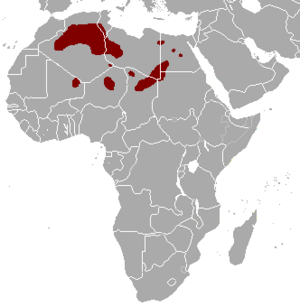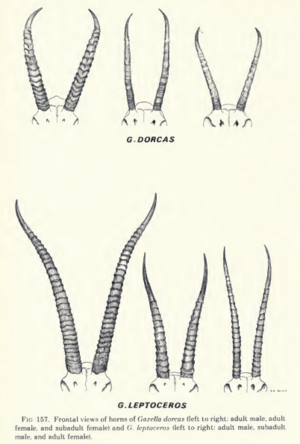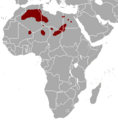Rhim gazelle facts for kids
Quick facts for kids Rhim gazelle |
|
|---|---|
 |
|
| At the Cincinnati Zoo | |
| Conservation status | |
| Scientific classification | |
| Subspecies | |
|
|
 |
|
| Distribution map | |
| Synonyms | |
|
The rhim gazelle (Gazella leptoceros), also called the slender-horned gazelle or African sand gazelle, is a light-colored gazelle with long, thin horns. It's really good at living in the desert. This amazing animal is an endangered species, which means there aren't many left in the wild – fewer than 2,500! You can find them in countries like Algeria, Egypt, Tunisia, and Libya. They might also live in Chad, Mali, Niger, and Sudan.
Contents
What's in a Name?
The name rhim comes from the Arabic word for this gazelle. In some places, like Tunisia and Egypt, people call it ghazal abiad, which means "white gazelle." This name fits because of its very pale fur.
A scientist named Frédéric Cuvier first described and named the rhim gazelle in 1842. Later, another person named Edmund Giles Loder rediscovered it. That's why it's also sometimes called Loder's gazelle.
What Does a Rhim Gazelle Look Like?

Rhim gazelles grow to be about 101 to 116 cm (40 to 46 in) long. They are the palest of all gazelles, which helps them blend in with the desert sand. Their top fur is light cream or buff, and their legs and belly are white.
The male gazelles have slender, slightly S-shaped horns. Female horns are even thinner and almost straight. Rhim gazelles have faint markings on their face and a light stripe along their side. Their tail is brownish-black and about 15 cm (6 in) long. It stands out against their pale rear.
Where Do Rhim Gazelles Live?
Rhim gazelles live in parts of Algeria, Tunisia, Libya, and Egypt. They have also been reported in Niger and Chad, but it's not totally clear if they still live there. These gazelles live in small, separate groups across the middle of the Sahara Desert.
The desert is super hot, so rhim gazelles usually eat in the early morning and evening. They get most of their water from dew and the moisture in plants. They don't need to drink much from open water sources. Rhim gazelles are nomadic, meaning they move around their desert home looking for plants to eat. They don't follow a set path. They usually live in sand dunes and the dips between them, but can also be found in rocky areas.
How Do They Survive the Desert Heat?
Rhim gazelles have a special way to deal with the extreme desert heat. It's called heterothermy. This means they don't keep their body temperature exactly the same all the time.
When it's very hot during the day, a rhim gazelle's body temperature can go up. This helps them save water because they don't need to sweat as much to cool down. Sweating uses up a lot of water. At night, when it's cooler, they release the stored heat. Their body temperature then goes back to normal.
In summer, their skin temperature is usually around 35°C (95°F). In winter, it's about 25°C (77°F). But when they use heterothermy, their body temperature can increase by 5-20°C (9-36°F) depending on the season. This amazing trick helps them save energy and water in their harsh home.
Why Are Rhim Gazelles Endangered?
By the early 1970s, the number of rhim gazelles was dropping fast. People used to hunt them for sport, meat, or their horns. The horns were sold as decorations in markets.
Today, the main dangers to rhim gazelles are poaching (illegal hunting), being disturbed by humans, and losing their natural home. The International Union for Conservation of Nature (IUCN) thinks there are only about 300 to 600 adult rhim gazelles left in the wild. Because of this, they are listed as an "endangered" animal. This means they are at a very high risk of disappearing forever.
Rhim Gazelles on Stamps
On February 1, 1987, Libya worked with the World Wide Fund for Nature to release a set of four postage stamps. These stamps showed pictures of the rhim gazelle!
Images for kids







